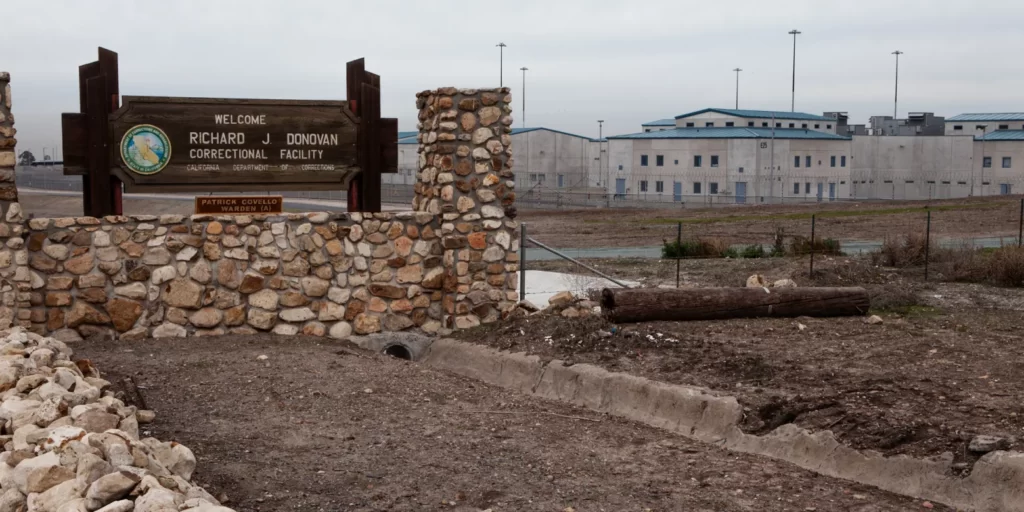Donovan Prison :- Located in the center of San Diego County, California, lies the Richard J. Donovan Correctional Facility, sometimes known as Donovan Prison, an imposing establishment with a name that conjures up memories. Beyond its intimidating exterior are tales of prisoners, charges of staff malfeasance, and a developing legal dispute that has the potential to alter the course of prison reform. Established in 1987, Donovan Prison is a maximum-security establishment that represents more than just its image; it is a complex institution where justice and responsibility are at stake.
The Hidden Stronghold
Located in San Diego County, California, Donovan Prison, sometimes called the Richard J. Donovan Correctional Facility, is a state prison. Under the control of the California Department of Corrections and Rehabilitation, it houses about 3,800 male prisoners. But this is a high-security fortress, not just any prison.
Numerous security measures are in place at this commanding institution to guarantee the protection of both employees and prisoners. The jail is equipped with electronic detection systems, metal detectors, body scanners, cameras, perimeter fencing, armed guards on duty around-the-clock, and stringent visitation regulations that forbid the import of illegal goods.
To ensure order and security within its walls, a strict system of inmate categorization separates high-risk convicts from those considered lower danger.
The Donovan Road
Donovan Prison was established as a result of expanding prisoner populations, overcrowding in state prisons, and a need for more space. It bears the name of Richard J. Donovan, a former state senator from California and city councilman for San Diego. The building was built in 1987 to house the growing number of prisoners in the state and to relieve congestion in other California state prisons.
Donovan Prison has expanded and renovated throughout time to enhance its amenities and security protocols. But it’s about more than just walls and bars—it’s about giving prisoners a chance at recovery and atonement.
Initiatives for Change
Beyond the intimidating walls of Donovan Prison, there are chances for transformation in addition to security. The jail provides its inmates with a range of programs designed to aid in their rehabilitation and personal development. Inmates have access to adult basic education, GED preparation, and even college courses as part of the educational programs.
Training in welding, culinary arts, and vehicle repair are all included in vocational programs. With the help of these programs, prisoners will be able to reintegrate into society after serving their sentences by gaining knowledge and skills.
In addition, the institution provides treatment programs that target problems including drug misuse, controlling one’s aggression, and cognitive-behavioral therapy. Additionally, self-help organizations, religious services, and leisure activities are available to prisoners. These programs demonstrate an effort to offer a route for rehabilitation and personal development while incarcerated, which is an essential component of any prison system.
A Court Case Seeking Reform
Donovan Prison has recently evolved into a theater of justice and accountability conflicts. In the Armstrong v. Newsom case, inmates with disabilities filed a lawsuit against the California Department of Corrections and Rehabilitation, requesting accountability and openness about claims of misbehavior by staff members. The proposed settlement aims to implement important changes.
Among other things, it requires correctional guards to wear body cameras, boosts staffing levels, increases video monitoring, and enhances staff investigation and disciplinary procedures.
Through an appeal submitted last autumn, the California Department of Corrections and Rehabilitation is vehemently opposing this settlement, nevertheless. By removing the court’s monitoring of the planned remedial plan, the appeal seeks to give the department more autonomy over how to carry out the required adjustments.
This action puts the advancement of disability rights for those who are detained in jeopardy since opponents wonder if the department can be trusted to carry out these improvements without the court’s participation.
The War for Equality
The Armstrong case, which dates back to the 1990s, is centered on the rights of people with disabilities who are detained. Some claimants have been denied access to work furloughs, credits, education programs, and other benefits available to convicts who are not handicapped. At first, the lawsuit was centered on the absence of appropriate accommodations and structural impediments.
Allegations of wrongdoing by correctional staff members, who are suspected of singled out and retaliating against individuals with disabilities, have centered around Donovan Prison in recent years.
The claims are concerning because over 25% of Donovan’s residents are physically disabled. Physical assaults, denial of medical attention, disregard for critical requirements, and reprisals against whistleblowers are a few of them. It is discrimination against residents with disabilities because of the environment of retaliation towards those who depend on the prison personnel for adjustments related to their handicap. In order to improve the protection of handicapped inmates at Donovan Prison, a court issued an order last autumn.
Attorneys for the residents and the department of prisons have been engaged in a protracted legal battle to decide on the appropriate course of action for more than a year. It is anticipated that the final corrective plan will be submitted to the court in October. There’s still uncertainty about the result, but one thing is certain—Donovan Prison is at a turning point.
The legal dispute that is currently raging inside its walls might alter the reform program inside the prison and impact the future of correctional facilities across the country.
Conclusion (Donovan Prison )
Donovan Prison, also known as the Richard J. Donovan Correctional Facility, is a reform and accountability crucible in addition to being a maximum-security prison. It is situated at a pivotal point in history, where the pursuit of justice and the defense of the rights and dignity of people with disabilities who are jailed are at odds.
With bated breath, the country awaits the verdict, hoping that those inside its walls will have a fairer and more just future. Donovan Prison is a symbol of progress in a society that frequently ignores the imprisoned; it is a site where every stone and barbed wire strand represents a battle for justice.
